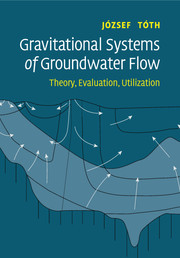Book contents
- Frontmatter
- Contents
- Preface
- 1 Introduction
- 2 The ‘Unit Basin’
- 3 Flow patterns in composite and heterogeneous basins
- 4 Gravity flow of groundwater: a geologic agent
- 5 Practical applications: case studies and histories
- 6 Epilogue: gravitational systems of groundwater flow and the science of hydrogeology
- Glossary
- References
- Appendices
- Appendix A
- Appendix B
- Index
2 - The ‘Unit Basin’
Published online by Cambridge University Press: 31 July 2009
- Frontmatter
- Contents
- Preface
- 1 Introduction
- 2 The ‘Unit Basin’
- 3 Flow patterns in composite and heterogeneous basins
- 4 Gravity flow of groundwater: a geologic agent
- 5 Practical applications: case studies and histories
- 6 Epilogue: gravitational systems of groundwater flow and the science of hydrogeology
- Glossary
- References
- Appendices
- Appendix A
- Appendix B
- Index
Summary
The Unit Basin is the elementary building concept in the theory of gravity-driven regional groundwater flow. It is envisaged as a two-dimensional vertical slab of unit thickness and of homogeneous and isotropic hydraulic conductivity of the Earth's crust (Fig. 2.1). On the top, it is bounded by an axially symmetrical topographic depression with water tables rising linearly from the central thalweg to the divides, by an effectively impermeable horizontal stratum at the base, and by two vertical planes forming the sides beneath the water divides. The sides are considered impervious to flow owing to the water table's symmetry relative to the divides. The basic pattern of regional groundwater flow is a steady-state flow-field, which develops in a saturated unit basin with gravity being the sole water-driving force. General flow patterns may be thought of as modified versions of the basic pattern. Commonly, general patterns can be resolved into cells or compartments in which flow characteristics are similar to those of the basic pattern.
The basic flow pattern
The Unit Basin as defined above is a conservative flow domain. In a conservative domain no sources or sinks of energy or flow occur. The distributions of hydraulic head and flow can thus be calculated by the Laplace equation (Eq. 1.2) using the appropriate boundary conditions (Fig. 2.1; App. A; Tóth, 1962a; Freeze and Witherspoon, 1967; Wang and Anderson, 1982; Zijl and Nawalany, 1993).
- Type
- Chapter
- Information
- Gravitational Systems of Groundwater FlowTheory, Evaluation, Utilization, pp. 26 - 32Publisher: Cambridge University PressPrint publication year: 2009



